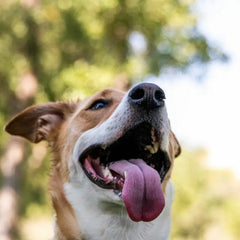Introduction
Garlic, a staple in many human diets, is renowned for its flavor-enhancing properties and potential health benefits. However, when it comes to our canine companions, the consumption of garlic becomes a topic of debate and concern. "Can my dog eat garlic?" is a question that resonates with many dog owners. This article dives into the complexities surrounding garlic in a dog's diet.
Garlic: A Culinary Delight with a Dark Side?
Garlic belongs to the Allium family, which also includes onions, leeks, and chives. While it's celebrated for its culinary and medicinal properties in human nutrition, its effects on dogs are vastly different.
Potential Benefits (largely anecdotal):
- Immune System Boost: Some believe garlic can enhance a dog's immune response.
- Flea Repellant: A few claim that feeding dogs small amounts of garlic can repel fleas.
However, these potential benefits are overshadowed by the proven risks garlic poses to dogs.

The Toxic Nature of Garlic for Dogs
Garlic contains compounds that can be harmful to dogs when ingested in significant quantities.
- Thiosulfate: Garlic contains thiosulfate, which dogs cannot properly digest. This compound can lead to hemolytic anemia, where the red blood cells burst while circulating in the body.
- Digestive Upset: Ingesting garlic can cause stomach upset, leading to symptoms like vomiting and diarrhea.
Toxicity Levels:
The size of the dog and the amount of garlic consumed play a role in the severity of the reaction. Generally, larger doses or regular consumption of small doses can lead to poisoning.
Symptoms of Garlic Poisoning
It's crucial for dog owners to recognize signs of garlic poisoning, as early intervention can make a significant difference.
Common Symptoms Include:
- Lethargy: Affected dogs may seem unusually tired or unresponsive.
- Vomiting or Diarrhea: Indicative of gastrointestinal upset.
- Abdominal Pain: The dog may show signs of discomfort or pain in the belly area.
- Pale Gums: A sign of potential anemia.
- Elevated Heart Rate: The dog's heart may beat faster than usual.
FAQs: Garlic Queries Answered
1. How much garlic is toxic to dogs?
The toxic dose varies based on the dog's weight and the type of garlic. Roughly, 15-30 grams of garlic per kilogram of body weight can be toxic. However, even small amounts can lead to issues over time.
2. My dog ate a small piece of garlic. What should I do?
While a tiny amount might not cause immediate harm, it's essential to monitor your dog for any symptoms and consult a veterinarian.
3. Are garlic supplements safe for dogs?
Many garlic supplements contain concentrated amounts of garlic. Always consult with a veterinarian before giving any supplements to your dog.
4. Why can humans eat garlic safely, but not dogs?
Dogs metabolize certain compounds, like thiosulfate, differently than humans. This difference makes substances that are safe for humans toxic to dogs.
5. Are there any safe alternatives to garlic for flea prevention?
Yes, numerous commercial flea preventatives are both safe and effective for dogs. Always consult with a veterinarian for recommendations.
Conclusion
While garlic might be a flavorful addition to our dishes, it's a potential danger for our furry friends. The risks associated with garlic consumption in dogs far outweigh any unproven benefits. As responsible pet owners, it's our duty to ensure our pets' safety and well-being. This includes being aware of food items that, while safe for us, can be harmful to them.




